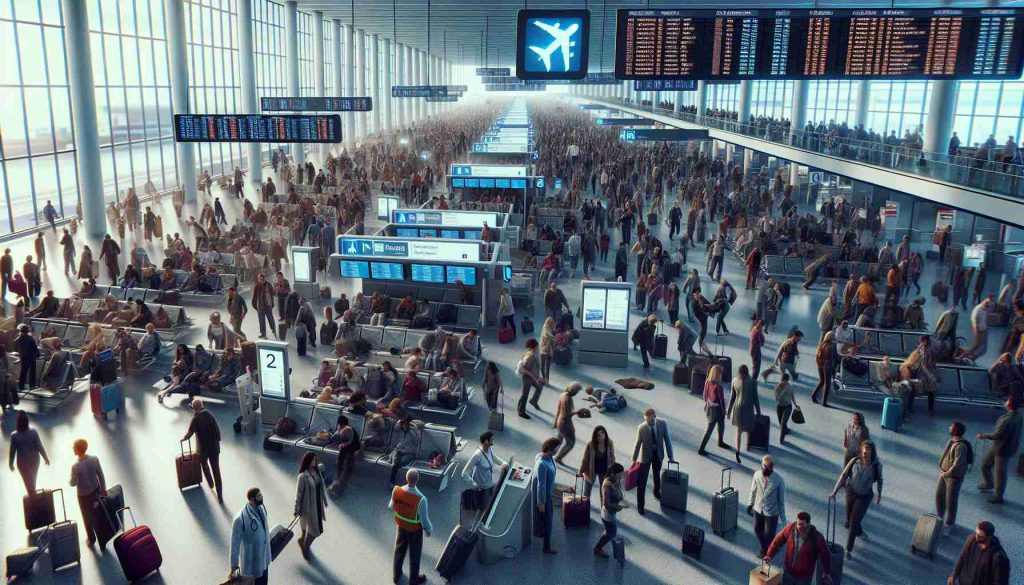Flight operations are in disarray, with long queues forming at airports worldwide, as a widespread technology glitch disrupts systems across the globe. Rather than smoothly processing flight data in mere seconds, manual efforts involving multiple individuals are now being scrambled to rectify the unpredictable repercussions of this unprecedented event.
With 250 flights scheduled at Valencia Airport today, both departures and arrivals are at risk of delays due to the ongoing tech crisis. Airport authorities are striving to mitigate issues for passengers and ensure minimal disruption to flight schedules amidst the chaos.
At Valencia Airport, the sight of open barriers and free parking services for several hours signals the unfolding crisis. Additional staff have been deployed to check-in counters, swiftly processing passengers and minimizing wait times to alleviate the strain on travelers.
Passengers like Luisa Raigón, setting off for Santiago, find themselves caught in the turmoil, resigned to potential delays amid the digital era’s vulnerabilities. While challenges persist for those with connecting flights, airport staff are dedicated to reducing inconvenience as much as possible, urging understanding from affected travelers.
A critical Microsoft tech failure is under scrutiny for triggering extensive disruptions at airports, airlines, banks, government agencies, and retail outlets globally. Investigations point to a flaw within Microsoft’s PC operating systems as the likely culprit behind this far-reaching crisis affecting numerous countries, including Spain.
Severe disruptions initially unfolding in the United States and Australia have now spread to Europe, impacting major airlines and grounding flights across key regions. The situation remains fluid as aviation authorities work tirelessly to restore normal operations amid this unparalleled tech upheaval.
Air Travel Chaos Intensifies with Global Tech Failure: New Developments and Key Considerations
The recent global tech failure that has triggered chaos in air travel continues to reveal new challenges and complexities as the situation evolves. While the previous article shed light on some aspects of the disruption, there are additional critical facts and considerations that deserve attention.
How Deep is the Impact of the Tech Failure on Air Travel Operations Worldwide?
The repercussions of the tech failure are reverberating across the aviation industry, raising concerns about the extent of the disruption. Not only are flights facing delays and cancellations, but the ripple effects are also affecting airport security, baggage handling, and flight coordination on a global scale.
What are the Key Challenges Faced by Airlines and Airports in Resolving the Crisis?
One of the primary challenges in addressing this tech failure is the sheer scale of coordination required among different stakeholders. Airlines, airport authorities, tech teams, and regulatory bodies must collaborate efficiently to troubleshoot the issues, implement solutions, and communicate effectively to minimize disruptions.
Advantages and Disadvantages of the Ongoing Manual Efforts to Manage Flight Operations
While manual interventions are crucial in mitigating the immediate impact of the tech failure, relying heavily on manual processes poses its own set of challenges. On one hand, it allows for quick decision-making and adaptability. On the other hand, it increases the risk of errors, communication breakdowns, and overall inefficiencies in the long run.
In light of the evolving crisis in air travel due to the global tech failure, stakeholders must prioritize proactive measures, contingency planning, and collaborative efforts to navigate through this unprecedented challenge successfully.
For more insights on the aviation industry and technology disruptions in air travel, visit Aviation News.










More Stories
Game-Changer in Delivery! Glovo’s Bold Move Stuns Spain!
Maximizing Returns Beyond Treasury Bonds
Exploring the Rising Trends in European Banking